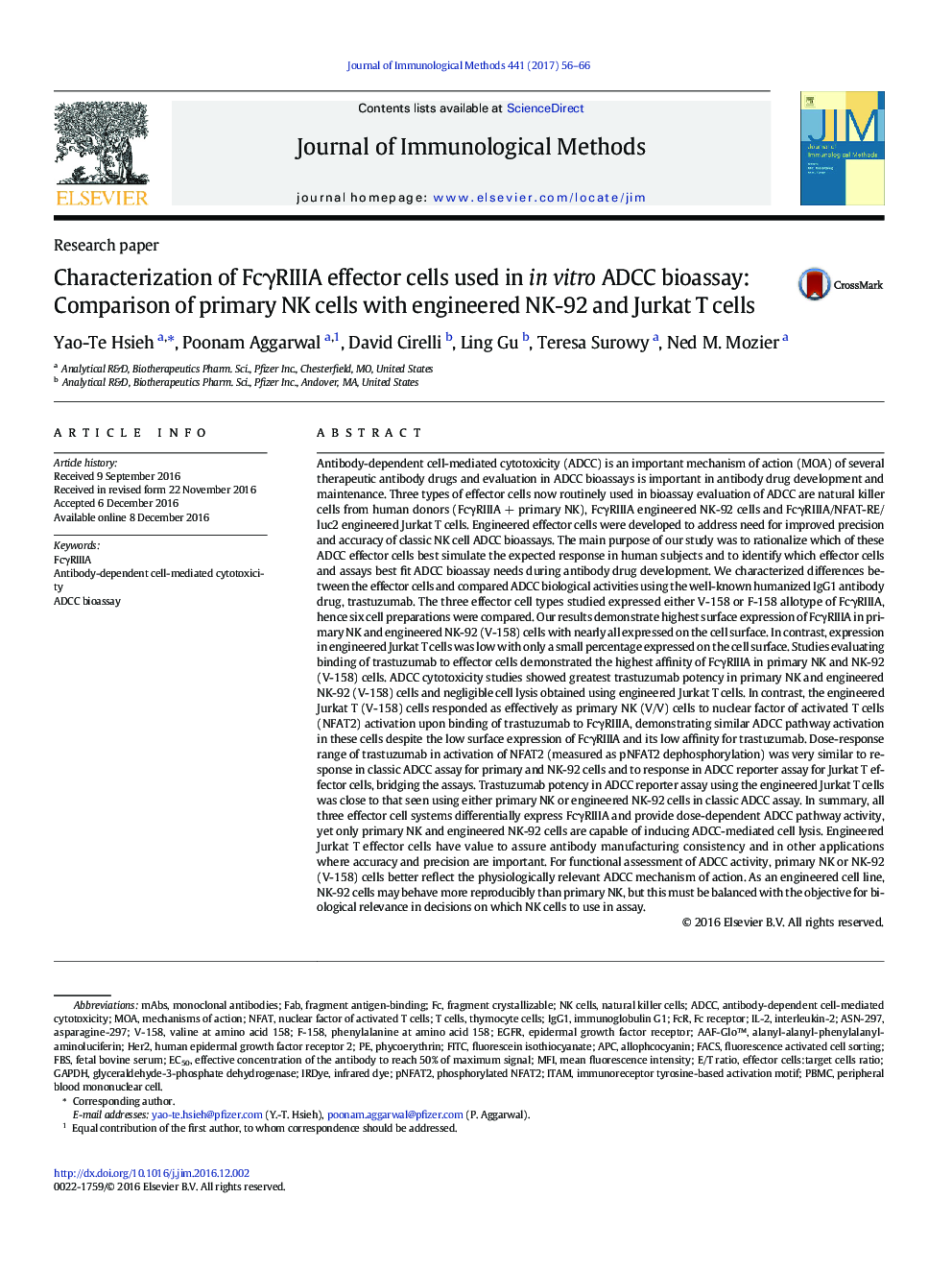| کد مقاله | کد نشریه | سال انتشار | مقاله انگلیسی | نسخه تمام متن |
|---|---|---|---|---|
| 5522091 | 1545668 | 2017 | 11 صفحه PDF | دانلود رایگان |

Antibody-dependent cell-mediated cytotoxicity (ADCC) is an important mechanism of action (MOA) of several therapeutic antibody drugs and evaluation in ADCC bioassays is important in antibody drug development and maintenance. Three types of effector cells now routinely used in bioassay evaluation of ADCC are natural killer cells from human donors (FcγRIIIA + primary NK), FcγRIIIA engineered NK-92 cells and FcγRIIIA/NFAT-RE/luc2 engineered Jurkat T cells. Engineered effector cells were developed to address need for improved precision and accuracy of classic NK cell ADCC bioassays. The main purpose of our study was to rationalize which of these ADCC effector cells best simulate the expected response in human subjects and to identify which effector cells and assays best fit ADCC bioassay needs during antibody drug development. We characterized differences between the effector cells and compared ADCC biological activities using the well-known humanized IgG1 antibody drug, trastuzumab. The three effector cell types studied expressed either V-158 or F-158 allotype of FcγRIIIA, hence six cell preparations were compared. Our results demonstrate highest surface expression of FcγRIIIA in primary NK and engineered NK-92 (V-158) cells with nearly all expressed on the cell surface. In contrast, expression in engineered Jurkat T cells was low with only a small percentage expressed on the cell surface. Studies evaluating binding of trastuzumab to effector cells demonstrated the highest affinity of FcγRIIIA in primary NK and NK-92 (V-158) cells. ADCC cytotoxicity studies showed greatest trastuzumab potency in primary NK and engineered NK-92 (V-158) cells and negligible cell lysis obtained using engineered Jurkat T cells. In contrast, the engineered Jurkat T (V-158) cells responded as effectively as primary NK (V/V) cells to nuclear factor of activated T cells (NFAT2) activation upon binding of trastuzumab to FcγRIIIA, demonstrating similar ADCC pathway activation in these cells despite the low surface expression of FcγRIIIA and its low affinity for trastuzumab. Dose-response range of trastuzumab in activation of NFAT2 (measured as pNFAT2 dephosphorylation) was very similar to response in classic ADCC assay for primary and NK-92 cells and to response in ADCC reporter assay for Jurkat T effector cells, bridging the assays. Trastuzumab potency in ADCC reporter assay using the engineered Jurkat T cells was close to that seen using either primary NK or engineered NK-92 cells in classic ADCC assay. In summary, all three effector cell systems differentially express FcγRIIIA and provide dose-dependent ADCC pathway activity, yet only primary NK and engineered NK-92 cells are capable of inducing ADCC-mediated cell lysis. Engineered Jurkat T effector cells have value to assure antibody manufacturing consistency and in other applications where accuracy and precision are important. For functional assessment of ADCC activity, primary NK or NK-92 (V-158) cells better reflect the physiologically relevant ADCC mechanism of action. As an engineered cell line, NK-92 cells may behave more reproducibly than primary NK, but this must be balanced with the objective for biological relevance in decisions on which NK cells to use in assay.
Journal: Journal of Immunological Methods - Volume 441, February 2017, Pages 56-66